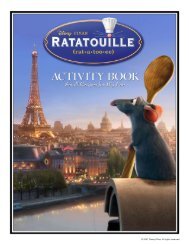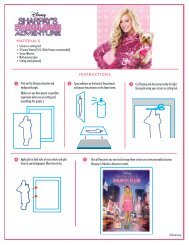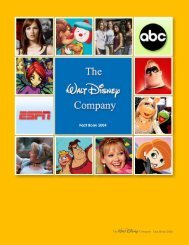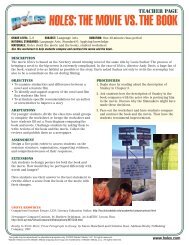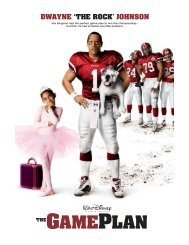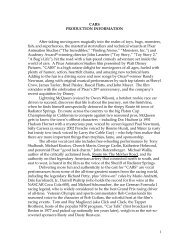(800) 295-5010 - Disney
(800) 295-5010 - Disney
(800) 295-5010 - Disney
You also want an ePaper? Increase the reach of your titles
YUMPU automatically turns print PDFs into web optimized ePapers that Google loves.
EDUCATOR’S GUIDE<br />
Cloning:<br />
The Science and<br />
the Controversy<br />
For six seasons, millions of students came to understand, appreciate and enjoy<br />
the exploration of science through the series, Bill Nye the Science Guy. Bill returns with<br />
The Eyes of Nye, a more in-depth look at science subjects making news, changing lives,<br />
and impacting policy. From the future of alternate fuel sources and genetic engineering to<br />
population growth trends and issues of race, Bill and his expert cohorts bring science to life<br />
right in your classroom, helping you Motivate investigation; Assess available information;<br />
and Propose lines of argumentation.<br />
the<br />
Presents<br />
Eyes<br />
of Nye<br />
This Educator's Guide includes:<br />
• An Introduction that clearly defines the subject and offers an overview of the issue<br />
objectives of the guide; how it relates to science from both a social and personal<br />
perspective; as well as pertinent questions and insights regarding the topic.<br />
• A listing of all National Science Education Standards Addressed.<br />
• Detailed procedures highlighted in the MAP Framework (Motivate, Assess, Propose).<br />
• Illustrative Video Clips from The Eyes Of Nye DVDs with pinpoint chapter cues.<br />
• Web Site Resources to help students further investigate and locate research, charts, data as<br />
well as experts featured in the program material.<br />
• Easily downloadable Support Materials that include articles, transparencies, charts, and<br />
much more.<br />
Introduction:<br />
“Cloning” refers to the creation of genetically identical living material. The Eyes of Nye –<br />
Cloning: The Science and the Controversy describes two types of cloning—reproductive and<br />
therapeutic. Reproductive cloning results in an entirely new living thing whereas therapeutic<br />
cloning results in stem cells that can be used for treatment of diseases and injuries.<br />
Cloning involves a variety of details and controversies. Helping students identify and examine<br />
cloning involves focusing on amounts of information that can be reasonably addressed as<br />
well as awareness that further investigations are needed to make informed decisions.The<br />
objectives in this guide focus on basic aspects of reproductive and therapeutic cloning—<br />
to help students learn to consider a socio-scientific issue that demands reckoning, to<br />
investigate both scientific and social aspects related to the issue, and to construct an<br />
Check the MAP<br />
Teaching and<br />
Learning<br />
Framework to<br />
explore the phases<br />
(motivate, assess,<br />
and propose) used<br />
in this guide.<br />
1 Educator’s Guide<br />
DEducational Productions (<strong>800</strong>) <strong>295</strong>-<strong>5010</strong><br />
© <strong>Disney</strong>
argument that describes a position and typifies a way of addressing similar issues that will<br />
arise throughout their lives.<br />
Presents<br />
National Science Education Standards Addressed<br />
Science As Inquiry<br />
• Abilities necessary to do scientific inquiry<br />
Identify questions and concepts that guide scientific investigations.<br />
Recognize and analyze alternative explanations and models.<br />
Communicate and defend a scientific argument.<br />
• Understanding about scientific inquiry<br />
the<br />
Eyes<br />
of Nye<br />
Life Science<br />
• The cell<br />
• The molecular basis of heredity<br />
Science in Personal and Social Perspectives<br />
• Science and technology in local, national, and global challenges<br />
History and Nature of Science<br />
• Science as a human endeavor<br />
• Nature of scientific knowledge<br />
2 Educator’s Guide<br />
DEducational Productions (<strong>800</strong>) <strong>295</strong>-<strong>5010</strong>
On the DVD:<br />
Cloning: The Science and the Controversy – Chapters<br />
Chapter 1: Cloning Preview<br />
Beginning to 01:37<br />
Ends with title screen.<br />
Chapter 2: Asexual Reproduction and the Process of Cloning<br />
01:37—05:05<br />
Ends with the close of the eyes in the dark.The actual program ends<br />
with Bill raising the issue,“Are we really ready to try it with humans?”<br />
the<br />
Presents<br />
Eyes<br />
of Nye<br />
Chapter 3: Cloning for Reproductive Purposes<br />
05:05—10:37<br />
Ends with Dr. Swalla raising the potential of therapeutic cloning as the<br />
alternative of choice.<br />
Chapter 4: Cloning for Therapeutic Purposes<br />
10:37—16:42<br />
Ends with a glowing endorsement of therapeutic cloning and sets stage<br />
for debate.<br />
Chapter 5: Stem Cell Research, Controversy, and Debate<br />
16:42—19:32<br />
Ends with the questions,“Can human embryos be declared inventions<br />
that we can patent?” and,“How can we pursue a thoughtful discussion<br />
of stem cell research?” which sets a stage for the importance of our own<br />
views, morals, and ethics and those predominant in our culture.<br />
Chapter 6: Bioethics and Social Policy Bioethics and Social Policy<br />
19:32—Through end<br />
Ends with the close of the program.<br />
Cloning: The Science and the Controversy – Activity Clips<br />
Process of Cloning and Somatic Cell Nuclear Transfer<br />
03:57—04:49<br />
(referenced in Educator’s Guide step 6)<br />
Divergence of Reproductive and Therapeutic Cloning<br />
09:57—11:30<br />
(referenced in Educator’s Guide step 8)<br />
Difficulties with Dolly<br />
04:50—05:04<br />
(referenced in Educator’s Guide step 9)<br />
3 Educator’s Guide<br />
DEducational Productions (<strong>800</strong>) <strong>295</strong>-<strong>5010</strong>
Research on Reproductive Cloning and Stem Cells<br />
06:41—09:17<br />
(referenced in Educator’s Guide step 9)<br />
Embryos and Babies<br />
11:16—12:01<br />
(referenced in Educator’s Guide step 10)<br />
Research on Therapeutic Cloning and Stem Cells<br />
12:05—15:21<br />
(referenced in Educator’s Guide step 10)<br />
the<br />
Presents<br />
Eyes<br />
of Nye<br />
Cloning Controversies and Claims<br />
9:17—9:57<br />
(referenced in Educator’s Guide step 11)<br />
Setting the Debate<br />
17:12—18:12<br />
(referenced in Educator’s Guide step 11)<br />
Procedure: Motivate Phase<br />
1) Ask students what the term “clone” means. Accept and record each on chart paper or<br />
blackboard. Discuss and group responses into categories that highlight aspects of the<br />
definition (e.g., remake/recreate, same/identical, genetic makeup/DNA, etc.) in order to<br />
obtain an agreed-upon definition.<br />
2) Based on the definition, ask students to describe what they think it means to clone.<br />
Responses will vary, but look for suggestions that imply process (e.g., making or creating a<br />
“clone”). Ask them to suggest what it means to make a clone. Students will likely focus on<br />
the more obvious aspects of reproductive cloning. Accept these but look for suggestions<br />
that imply cloning for other purposes. Discuss and probe students’ level of awareness of<br />
therapeutic cloning. Describe the differences.<br />
reproductive cloning: process of creating a new living thing with the identical genetic<br />
makeup of another living thing.<br />
therapeutic cloning: process of creating genetically identical stem cells for use in the<br />
treatment of disease or physical injury and rehabilitation.<br />
3) Tell students to keep in mind the definitions as you play “Chapter 1: Cloning Preview”.<br />
Wait a moment to repeat the question posed,“Should we pursue cloning?” Most<br />
comments will be decisive but based on opinion and emotion.Wait until a comment<br />
is made in the form of a question, and then lead from that point to a brief discussion<br />
about the “need-to-know” certain information before we can make decisions. Ask<br />
students to suggest questions that might address this information, distinguishing<br />
between questions that are “scientific” and “social” (e.g., societal, economic, political).<br />
Narrow the questions to a few “scientific” and at least one “social”.<br />
4 Educator’s Guide<br />
DEducational Productions (<strong>800</strong>) <strong>295</strong>-<strong>5010</strong>
Potential scientific questions<br />
a) What are the processes involved in reproductive and therapeutic cloning, and how are<br />
these different and similar?<br />
b) What scientific difficulties and/or opportunities might result from cloning?<br />
Potential social questions<br />
c) What are the ethical, economic, and/or political considerations?<br />
4) Explain though we can explore questions, we cannot conduct experiments that<br />
prove or refute lab-derived data and claims of scientists.We can, however, learn<br />
the complexities and processes involved in making a decision. Leave students with<br />
the following: When societies make decisions, such as whether to allow cloning<br />
research, do they have all the information needed? If not, must they still make those<br />
decisions? Students will soon understand answers are “no” and “yes,” respectively.<br />
Procedure: Assess Phase<br />
5) Tell students they will focus first on the initial scientific question identified above. Recall<br />
the definition and descriptions of cloning; ask them what comes to mind. Expect a<br />
dramatic set of “baby assembly line” visions, but suggest there may be more to it than<br />
that.Tell them they will explore the process of cloning.<br />
6) Ask students to take notes as you play “Process of Cloning and Somatic Cell Nuclear<br />
Transfer“ describing the process of cloning and somatic cell nuclear transfer. Divide class<br />
into groups of 3-4 students. Ask students in each to compare notes and construct a<br />
diagram (illustrations and text) that describes the process. Give each a transparency (or<br />
chart paper).You may allow students to view the segment again by setting up a viewing<br />
zone. Use diagrams and information below to guide the discussion that follows.<br />
the<br />
Presents<br />
Eyes<br />
of Nye<br />
Teacher Note: The steps in cloning and SCNT are illustrated in the transparency T-CP, used<br />
through step 9. An optional transparency T-NR is provided for comparing the process of normal<br />
reproduction to that used in cloning.<br />
7) When groups have completed the outlines, ask each to present the steps. Discuss<br />
similarities and differences in each group’s process description. Use transparencies<br />
provided to reinforce the process and allow students to modify and take notes.<br />
See The Eyes<br />
of Nye<br />
Issue Support<br />
Process of<br />
Cloning.<br />
You may use the transparency T-NR to illustrate the difference between<br />
normal reproduction and reproductive cloning, depending on the amount of<br />
background your students have had.<br />
5 Educator’s Guide<br />
DEducational Productions (<strong>800</strong>) <strong>295</strong>-<strong>5010</strong>
8) Play “Divergence of Reproductive and Therapeutic Cloning.” Ask students to describe<br />
the “fork.” Use transparency T-CP to emphasize where therapeutic and reproductive<br />
cloning processes diverge.<br />
Presents<br />
9) Play “Difficulties with Dolly,” introducing students to problems scientists had cloning<br />
Dolly the Sheep and leaving them with the question,“Are we really ready to try it<br />
(cloning) with humans?” Ask students to recall the questions we identified for<br />
investigation, and point out the second question dealing with the scientific<br />
difficulties and opportunities of cloning. Ask students to suggest difficulties or<br />
opportunities presented in cloning. Other than our presently low success rates (1-<br />
2%), they will have few suggestions. Re-emphasize need-to-know. Ask students to<br />
take notes as you play “Research on Reproductive Cloning and Stem Cells”<br />
featuring Dr. Billie Swalla and its discussion of stem cell research and reproductive<br />
cloning.<br />
10) Relate above information to the cloning process and the description of therapeutic<br />
cloning presented earlier. Ask students to suggest other opportunities or difficulties that<br />
might be faced in therapeutic cloning.Tell them to take notes as you play “Research on<br />
Therapeutic Cloning and Stem Cells” in which Dr. Hans Keirstead discusses his research<br />
on therapeutic cloning at the Reeve-Irvine Research Center in California. Discuss positive<br />
prospects (e.g., disease and repair of injured tissues) presented, and ask students if they<br />
saw any problems with the research being done.There won’t be many offered, given<br />
the perspective presented. Ask if anyone recalled what type of stem cell Dr. Keirstead<br />
was using (human embryonic). Ask them what that means. Ask students if there are<br />
non-scientific questions we need to investigate—recall the social question(s)<br />
mentioned earlier.<br />
Play “Embryos and Babies” to learn about embryonic stem cells and<br />
distinctions between embryos and babies.<br />
For more on stem cell research, go to eyesofnye.org<br />
the<br />
Eyes<br />
of Nye<br />
Teacher Note: Before proceeding into social questions related to cloning, discuss the<br />
importance of not only obtaining evidence from experts but also considering reasons for<br />
their perspectives; it is a difficult undertaking. Also, though this guide approaches scientific<br />
and social aspects separately, note when we consider pros and cons, counterarguments to a<br />
scientific claim are often social in nature and vice versa. Discuss with students science, for all its<br />
reliance on evidence, is a part of society.<br />
For more on exploring claims and claimants, go to eyesofnye.org.<br />
6 Educator’s Guide<br />
DEducational Productions (<strong>800</strong>) <strong>295</strong>-<strong>5010</strong>
11) Write the words reproductive and therapeutic cloning, and ask students to suggest<br />
advantages or disadvantages of each. Construct a T-chart to record responses (see<br />
sidebar). Model the act of “turning” suggestions, as advantages may often be viewed<br />
from the opposite direction as disadvantages, and vice versa. Help reword suggestions<br />
(three to five) to ensure the information is sufficient to construct arguments in the<br />
next phase.View the list of social concerns of cloning at the beginning of “Chapter<br />
3: Cloning for Reproductive Purposes”. Ask students to modify their list and<br />
identify one or two items they believe are important when deciding whether or<br />
not to clone.Tell them that though views vary, they may be interested in Dr.<br />
Swalla’s opinion. Play “Cloning Controversies and Claims“ where she presents<br />
two focal controversies regarding cloning. Reiterate these along with her (as with<br />
Dr. Keirstead’s) support of cloning for therapeutic purposes. Ask if therapeutic<br />
cloning involves human embryos (recall Dr. Keirstead’s comment in step 10).<br />
Play “Setting the Debate” and close with these questions: Should human embryos<br />
be declared inventions that you could patent? How do we pursue a thoughtful<br />
discussion of stem cell research?<br />
The first item on the list of concerns in Chapter 3 relates to conflicts of interest<br />
between researchers and biotech firms.<br />
For more on exploring claims and claimants, go to eyesofnye.org.<br />
Procedure: Propose Phase<br />
12) Tell students that they are now going to play a role as either a proponent or opponent of<br />
cloning. As a “proponent” their task will be to construct and write an argument in favor of<br />
a cloning proposition. As an “opponent” their task is similar, but they are to construct a<br />
case against the proposition. Use the following scenario.Tell students, “Proposition 33 has<br />
recently been placed on the ballot for a statewide vote.You and your colleagues (classmates)<br />
are to construct an argument for voting yes or no to the proposition, and write it so it<br />
convinces voters of your cause.”<br />
Proposition 33: Establishes the constitutional right to conduct stem cell research and a<br />
state institute to regulate and provide funding for research through grants and loans.<br />
Prohibits funding of human reproductive cloning research. Provides $2 million to the<br />
institute for start-up expenses, and projections of cost to the state will average approximately<br />
$4 billion over 30 years to pay off both the principal ($2 billion) and interest ($2<br />
billion) on the bonds.<br />
13) Assign each student a role—research scientist, community member, or politician.Tell each<br />
to choose (or assign) a stance “for Proposition 33” or “against<br />
Proposition 33” and join the others with the same role and stance.<br />
Explain the task of their “expert” group is to outline an argument<br />
(for or against) that represents the perspectives of their role (provided<br />
on the Proposition 33 Prep Cards). Distribute the cards, and allow<br />
students to construct their points. Instruct each student to write the<br />
points the group has agreed upon.<br />
the<br />
Presents<br />
Eyes<br />
of Nye<br />
Check the sample<br />
pros and cons<br />
of cloning.<br />
See The Eyes of<br />
Nye Issue Support<br />
Cloning<br />
Arguments<br />
and Counters<br />
7 Educator’s Guide<br />
DEducational Productions (<strong>800</strong>) <strong>295</strong>-<strong>5010</strong>
General role perspectives are provided, but students should decide views.<br />
A “community member” may be a parent, a retired person, etc. A parent<br />
“for Proposition 33” may have a child with spinal damage. A parent<br />
“against Proposition 33” may be worried about their daughter being<br />
coerced into selling her eggs.<br />
Check the support for student role cards that can be printed, cut out, and laminated.<br />
See the Eyes of Nye Issue Support Proposition 33 Prep Cards.<br />
14) Rearrange class into six groups—three “for” and three “against”—so each<br />
includes one member from each role (for instance, one “expert” who prepared<br />
as a research scientist, community member, and politician “for Proposition 33”<br />
and the same against). Assign each group a code (for instance A, B, C “for” and A, B, C<br />
“against”), and ask each to construct an argument that draws from the information<br />
obtained by “experts” in the previous step.They do not have to use every argument, but<br />
should try to equally represent the points made by each role. Allow one class period.<br />
the<br />
Presents<br />
Eyes<br />
of Nye<br />
You may provide as many challenges or assistance as you feel is warranted.<br />
For instance, students may be forewarned that:<br />
• Scientific arguments should outweigh opinion, but don’t count on it if the opinions<br />
are expressed persuasively enough.<br />
• Facts and figures are powerful, but can play against you unless sources are credible<br />
and data is consistent with acceptable science norms (see “assess” phase of MAP)<br />
• Where opinions or inferences are used, good arguments consistently build from<br />
specific data to those viewpoints and opinions (see “propose” phase of MAP).<br />
See “assess”<br />
and “propose”<br />
phases in<br />
MAP<br />
Framework<br />
15) Tell students to construct a rebuttal (also to be published) to one of the opposing<br />
arguments. Ask matched groups to exchange arguments (for instance, group “A for<br />
Proposition 33” with group “A against Proposition 33”). Emphasize the nature and<br />
purpose of a rebuttal, and its importance as possibly the last opportunity to refute the<br />
claims of the other argument in writing before the voting public.<br />
16) Ask each group to return their rebuttal to the group that constructed the argument, and<br />
discuss the argument points and rebuttals students have developed.You may arrange to<br />
have students take turns presenting their arguments and rebuttals, provide all students in<br />
the class with a printed copy of each for discussion, or arrange a vote by students or<br />
teachers who have not been part of the activity. Close with discussing the<br />
challenges in dealing with data that results from both “science-in-themaking”<br />
and “core science” (proven and accepted through validation<br />
and consensus in the scientific community).You may choose to have<br />
students modify questions and re-enter the “assess” phase to<br />
delve deeper into the issue of cloning.<br />
8 Educator’s Guide<br />
DEducational Productions (<strong>800</strong>) <strong>295</strong>-<strong>5010</strong>
Final Teacher Note: The Proposition 33 scenario is based on a similar situation that took place in<br />
California in 2004. Students will find it interesting to compare their arguments and rebuttals with<br />
those actually constructed by proponents and opponents of Proposition 71 (see The Eyes of Nye<br />
Issue Support). Should you choose, additional reinforcement of the relation of the issue of<br />
cloning to ethics and social policy can be provided through use of<br />
“Chapter 6: Bioethics and Social Policy”<br />
To further emphasize students’ likely participation in such an issue in the near future,<br />
explore past and impending cloning legislation.<br />
For more, go to eyesofnye.org.<br />
the<br />
Presents<br />
Eyes<br />
of Nye<br />
Further Research<br />
Investigating the Issue: Cloning<br />
Making decisions and constructing lines of argumentation related to an issue requires<br />
students obtain and assess information related to scientific and social aspects of the issue,<br />
and particularly pertaining to claims made regarding the issue. Scientific aspects of claims<br />
(e.g., data, evidence) are analyzed and assessed according to adherence to accepted scientific<br />
norms (constitutive criteria such as accuracy, precision, and consistency). Social aspects of<br />
claims are analyzed and assessed according to contextual criteria such as potential bias and<br />
qualifications of “expert” claimants and/or their sponsoring organizations as well as corroboration<br />
of viewpoints.<br />
In addition to the information and claims presented in The Eyes of Nye - Cloning, students may<br />
access a variety of informative sources related to cloning to assist them in assessing both<br />
scientific and social aspects of claims made.Teachers may direct them to specific information<br />
or leave research tasks as open as they feel is necessary for students to adequately explore<br />
and assess cloning information.<br />
Exploring Stem Cell Research<br />
The National Institutes of Health (NIH) provides useful information for teachers and students<br />
who wish to obtain additional data and/or descriptions regarding stem cell research.These<br />
resources are particularly helpful during the “assess” phase of the educator’s guide as students<br />
investigate scientific evidence related to the issue of cloning, and as they construct and<br />
analyze lists of pros and cons related to therapeutic and reproductive cloning.<br />
Access at:<br />
http://stemcells.nih.gov/index.asp<br />
Exploring Cloning Claims and Claimants<br />
An important aspect of dealing with socio-scientific issues involves looking beneath the<br />
scientific evidence and viewpoints expressed by acquiring additional information on the<br />
experts themselves as well as the organizations for whom they are affiliated.Through such<br />
exploration, students are better able to infer social (contextual) factors that may influence the<br />
9 Educator’s Guide<br />
DEducational Productions (<strong>800</strong>) <strong>295</strong>-<strong>5010</strong>
claims. In The Eyes of Nye - Cloning, the principal information was provided by Doctors Hans<br />
Keirstead, Billie Swalla, and Jeffrey Kahn.Teachers may encourage students to conduct openended<br />
searches for this type of information, or direct students to the links provided below.<br />
Presents<br />
Dr. Billie Swalla, scientist<br />
Dr. Hans Keirstead, scientist<br />
Dr. Jeffrey Kahn, director<br />
University of Washington, Dept. of Biology<br />
Reeve-Irvine Research Center (at the University<br />
of California)<br />
Center for Bioethics (at the University<br />
of Minnesota)<br />
Exploring “experts” beyond information offered at sites such those above often reveals<br />
additional details that may be relevant to discussions and students’ attempts to learn<br />
more about potential bias that may accompany expert claims. For instance, one concern of<br />
note in The Eyes of Nye - Cloning and discussed in the “assess” phase of the educator’s guide<br />
dealt with potential conflicts of interest between researchers and biotech firms. For example,<br />
you may wish students to access information (which also may be subject to assessment of<br />
credibility) on Dr. Keirstead’s recently formed biotech company and some of its subsequent<br />
activities through standard search procedures.<br />
Exploring Past and Impending Cloning Legislation<br />
As an issue, cloning is particularly relevant to students from the perspective of a future voter.<br />
Depending on when you are teaching with these materials, some 12th grade students<br />
presently studying the issue in your class may in fact be called upon this year to vote<br />
on impending state legislation.The educator guide that accompanies The Eyes of Nye -<br />
Cloning makes use of students’ interest in past and impending (future) legislation in<br />
the “propose” phase.<br />
The most significant past legislation that reinforces students’ work in the “propose” phase<br />
(constructing and proposing arguments and rebuttals) is California’s recent Proposition 71,<br />
approved by voters in a statewide vote in 2004. Students can access the actual Proposition 71<br />
arguments and rebuttals, published by the League of Women Voters in California.They may<br />
also conduct searches for the most recent legislation (or events in their state that indicate<br />
impending legislation in which they may be called to take an active role as a registered voter).<br />
the<br />
Eyes<br />
of Nye<br />
10 Educator’s Guide<br />
DEducational Productions (<strong>800</strong>) <strong>295</strong>-<strong>5010</strong>
ISSUES SUPPORT MATERIAL<br />
Cloning:<br />
The Science and<br />
the Controversy<br />
Process of Cloning<br />
(Transparency T-CP)<br />
the<br />
Presents<br />
Eyes<br />
of Nye<br />
1 Issues Support Material<br />
© <strong>Disney</strong><br />
DEducational Productions (<strong>800</strong>) <strong>295</strong>-<strong>5010</strong>
Normal Reproduction<br />
(Transparency T-NR)<br />
Presents<br />
the<br />
Eyes<br />
of Nye<br />
2 Issues Support Material<br />
DEducational Productions (<strong>800</strong>) <strong>295</strong>-<strong>5010</strong>
Cloning Arguments and Counters<br />
Reproductive cloning<br />
Presents<br />
Advantages<br />
• Saves time by creation of stock of “model”<br />
animals for disease research, access to<br />
naturally produced substances that are<br />
useful in medicine, or improvement of<br />
breeding processes.<br />
• Prevention or reversal of extinction of<br />
certain species of animals.<br />
• Replacement of lost (deceased) pet.<br />
• Assistance for couples with difficulties<br />
having children.<br />
Disadvantages<br />
• The time lost by the unsuccessful<br />
attempts (98 or 99 out of 100) in<br />
the short run offsets the time<br />
lost by normal breeding<br />
processes in the long run,<br />
not the mention the cost involved<br />
in the unsuccessful attempts.<br />
• The cells are seldom preserved in a<br />
usable state. Many animals that have died<br />
are also old, and as animals age the DNA<br />
telomeres shorten, so use of adult stem cells<br />
may result in shortened life spans.<br />
• Moral or ethical dilemma.There is also no<br />
indication that because a cloned living<br />
organism is genetically identical that it will<br />
be the same as the original organism.<br />
• There are other options for these couples<br />
that are more tried and tested, and more<br />
economically feasible.<br />
the<br />
Eyes<br />
of Nye<br />
Therapeutic cloning<br />
Advantages<br />
• Adult and embryonic stem cell research and<br />
applications offer unique opportunities for<br />
treatment of disease or repair of damaged<br />
tissues or limbs that could perhaps not be<br />
otherwise cured or treated.<br />
• Stem cells replicate and can be kept for<br />
indefinite periods of time in the right<br />
conditions, ensuring lasting numbers of<br />
usable cells from small initial collections.<br />
• Stem cells are readily available.<br />
Disadvantages<br />
• Stem cell treatments are relatively new and<br />
untested, primarily only on certain nonhuman<br />
test animals, with low success rates<br />
and high costs, and almost no long-term<br />
(longitudinal) data on effects or results.<br />
• Maintenance of cells is expensive and time<br />
consuming, and a security concern, as these<br />
cells represent ways to produce a clone of<br />
the donor or from an embryo.<br />
• Obtaining embryonic stem cells involves<br />
using embryonic remains or harvesting<br />
procedures, therefore destroying an<br />
embryo. Obtaining adult stem cells can<br />
involve intrusive surgical procedures (e.g.,<br />
extracting stem cells from bone marrow).<br />
3 Issues Support Material<br />
DEducational Productions (<strong>800</strong>) <strong>295</strong>-<strong>5010</strong>
Proposition 33 Prep Cards<br />
Community member<br />
A community member may be one of any number of individuals much like those you see<br />
and speak with every day. Parents, teachers, retired persons, and local workers at stores or<br />
construction sites are all community members.<br />
Concerns that you may or may not have are largely determined by the particular role<br />
you choose.The primary concerns of a mother or father (parent) would likely be your<br />
children, including possibly their health or an injury a child may have, or an impressionable<br />
daughter who has begun producing eggs. A retired person may be concerned<br />
with the effect of additional bonds and taxes on his fixed income. Create your character,<br />
and think like him/her.<br />
You are likely to direct your arguments toward members in the community that can relate<br />
with you or have similar situations or concerns.<br />
Research scientist<br />
A research scientist may be involved either directly or indirectly with researching stem cells,<br />
reproductive cloning, or related specialty areas. Scientists at universities, research institutes, or<br />
biotechnology firms are all good examples that fit the role.<br />
Your concerns are largely scientific—you want to see (and show) the evidence, and to back<br />
that up with data, claims from other reputable scientists, and outside theory where possible.<br />
However, you are also a person, and you have social interests; these range from adhering to<br />
the policy and position of the organization for which you work to your own moral opinions, as<br />
well as the well-being of your fellow man. Construct your character’s situation, qualifications,<br />
and view, and assemble your thoughts and points of argument as would that character.<br />
Though your opinions and situation influence your own view and possibly what you intend<br />
to propose, you are likely to direct your arguments to science and evidence, because that is<br />
your specialty as well as the expectation of those around you.<br />
Politician<br />
A politician may be a state senator, representative, or even an elected judge or local city<br />
official. He/she may also be of any of several party affiliations, or an independent.<br />
Your concerns are partly those of your voting constituency, and partly a result of your own<br />
beliefs.You may have a variety of positions, and these are influenced greatly by the<br />
viewpoints of voters in your state, region or city/county.Your concerns are also influenced by<br />
timing—a vote is around the corner.<br />
You are likely to select and use arguments that are as close as possible to both your own<br />
personal views and those of the voting public on whom you depend for re-election.You<br />
choose language carefully, you respect science but are very attuned to the impact of morals<br />
and beliefs, one way or the other, on final decisions that are made upon voting.<br />
4 Issues Support Material<br />
DEducational Productions (<strong>800</strong>) <strong>295</strong>-<strong>5010</strong><br />
the<br />
Presents<br />
Eyes<br />
of Nye
ARGUMENTS AND REBUTTALS<br />
Proposition 71<br />
Presents<br />
Stem Cell Research. Funding. Bonds.<br />
Initiative Constitutional Amendment and Statute.<br />
2004 argument published by the CA Secretary of State<br />
http://www.voterguide.ss.ca.gov/propositions/prop71-arguments.htm<br />
ARGUMENT in Favor of Proposition 71<br />
PROPOSITION 71 IS ABOUT CURING DISEASES AND SAVING LIVES.<br />
Stem cells are unique cells that generate healthy new cells, tissues, and organs. Medical<br />
researchers believe stem cell research could lead to treatments and cures for many<br />
diseases and injuries, including: Cancer, heart disease, diabetes, Alzheimer's, Parkinson's,<br />
HIV/AIDS, multiple sclerosis, lung diseases, and spinal injuries. In fact, medical problems that<br />
could benefit from stem cell research affect 128 million Americans-including a child or adult in<br />
nearly half of all California families.<br />
71 CLOSES THE RESEARCH GAP.<br />
Unfortunately, political squabbling has severely limited funding for the most promising areas<br />
of stem cell research. Meanwhile, millions of people are suffering and dying.<br />
Prop. 71, the California Stem Cell Research and Cures Initiative, is an affordable solution that<br />
closes the research gap, so new treatments and cures can be found.That's why a YES vote on<br />
71 is endorsed by a broad coalition that includes OVER 20 NOBEL PRIZE WINNING SCIENTISTS,<br />
doctors, nurses, Democrats, Republicans, and dozens of organizations, including:<br />
• Alzheimer's Association, California Council<br />
• American Nurses Association of California<br />
• California Medical Association (representing 35,000 doctors)<br />
• Cancer Research and Prevention Foundation<br />
• Christopher Reeve Paralysis Foundation<br />
• Cystic Fibrosis Research, Inc.<br />
• Elizabeth Glaser Pediatric AIDS Foundation<br />
• Juvenile Diabetes Research Foundation<br />
• Michael J. Fox Foundation for Parkinson's Research<br />
• Prostate Cancer Foundation<br />
• Sickle Cell Disease Foundation of California<br />
the<br />
Eyes<br />
of Nye<br />
5 Issues Support Material<br />
DEducational Productions (<strong>800</strong>) <strong>295</strong>-<strong>5010</strong>
71 PROTECTS CALIFORNIA'S TAXPAYERS AND BUDGET.<br />
Prop. 71 doesn't create or increase any taxes.<br />
It authorizes tax-free state bonds that will provide a maximum of $350 million per year over<br />
ten years to support stem cell research at California universities, medical schools, hospitals,<br />
and research facilities.<br />
• These bonds are self-financing during the first five years, so there's no cost to the<br />
State's General Fund during this period of economic recovery.<br />
• By making California a leader in stem cell research and giving our State an<br />
opportunity to share in royalties from the research, 71 will generate thousands of<br />
new jobs and millions in new state revenues.<br />
That's why California's Chief Financial Officers, State Controller Steve Westly and State<br />
Treasurer Phil Angelides, endorse Prop. 71.<br />
STRICT FINANCIAL AND ETHICAL CONTROLS.<br />
Research grants will be allocated by an Independent Citizen's Oversight Committee, guided<br />
by medical experts, representatives of disease groups, and financial experts- and subject to<br />
independent audits, public hearings, and annual public reports. Prop. 71 also prohibits any<br />
funding for cloning to create babies, reinforcing existing state law banning human reproductive<br />
cloning. It's totally focused on finding medical cures.<br />
71 COULD REDUCE HEALTH CARE COSTS BY BILLIONS.<br />
California has the nation's highest total health care spending costs-over $110 billion annually.<br />
A huge share of those costs is caused by diseases that could be treated or cured with stem<br />
cell therapies.<br />
• If Prop. 71 leads to cures that reduce our health care costs by only 1%, it will pay for<br />
itself-and it could cut health care costs by tens of billions of dollars in future decades.<br />
For more information visit www.YES on71.com.<br />
Vote YES on 71-IT COULD SAVE THE LIFE OF SOMEONE YOU LOVE.<br />
ALAN D. CHERRINGTON, Ph.D., President, American Diabetes Association<br />
CAROLYN ALDIGE, President, National Coalition for Cancer Research (NCCR)<br />
JOAN SAMUELSON, President, Parkinson's Action Network<br />
REBUTTAL to Argument in Favor of Proposition 71<br />
Stem Cell Research? YES! Human Embryo Cloning? NO!<br />
Here are just some of the many problems with Proposition 71:<br />
• It specifically supports “embryo cloning” research- also called "somatic cell nuclear<br />
transfer"-which poses risks to women and unique ethical problems.To provide scientists<br />
with eggs for embryo cloning, at least initially, thousands of women may be subjected to<br />
the substantial risks of high dose hormones and egg extraction procedures just for the<br />
the<br />
Presents<br />
Eyes<br />
of Nye<br />
6 Issues Support Material<br />
DEducational Productions (<strong>800</strong>) <strong>295</strong>-<strong>5010</strong>
purposes of research. In addition, the perfection of embryo cloning technology- even if<br />
initially for medical therapies only-will increase the likelihood that human clones will be<br />
produced.<br />
• Why privilege this research over other important research and medical needs,<br />
especially given the limits on how much California can invest? Why not issue bonds<br />
for programs that ALREADY have proven their cost effectiveness? Embryo stem<br />
cell research in nonhuman animals has produced only limited results. More<br />
compelling evidence of its efficacy should be required before a large<br />
commitment of public resources to study it in humans.<br />
• Proponents are manipulating those seeking cures, building false hopes with<br />
exaggerated claims, and creating a costly program without adequate oversight or<br />
accountability.<br />
Stem cell research should be supported, but not this way. And don't be fooled by those who<br />
say that the opponents of Proposition 71 are all opposed to abortion and embryo stem cell<br />
research. Many of us are pro-choice, do not oppose all embryo stem cell research, and still<br />
oppose this initiative.<br />
Vote “No” on Proposition 71.<br />
JUDY NORSIGIAN, Executive Director, Our Bodies Ourselves<br />
FRANCINE COEYTAUX, Founder, Pacific Institute for Women's Health<br />
TINA STEVENS, Ph.D., Author, Bioethics in America: Origins and Cultural Politics<br />
ARGUMENT Against Proposition 71<br />
WE SUPPORT STEM CELL RESEARCH, NOT CORPORATE WELFARE<br />
It's wrong to launch a costly new state bureaucracy when vital programs for health,<br />
education, and police and fire services are being cut.We cannot afford to pile another $3<br />
billion in bonded debt on top of a state budget teetering on the edge of financial ruin.<br />
General Fund bond debt will grow from $33 Billion on May 1, 2004, to a Legislative<br />
Accounting Office projection of $50.75 Billion in debt by June 30, 2005-a staggering 54%<br />
increase in just 14 months!<br />
WHO BENEFITS?<br />
Backers will cynically use images of suffering children and people with disabilities in their<br />
commercials, but pharmaceutical company executives and venture capitalists contributed<br />
$2.6 million to put this measure on the ballot. By getting taxpayers to fund their corporate<br />
research, they stand to make billions with little risk.<br />
NO ACCOUNTABILITY<br />
And who will oversee how this money is spent? According to the fine print, the proponents<br />
give themselves power to exempt their "Institute for Regenerative Medicine" from aspects<br />
of our California "open meeting" law (specifically passed to stop this kind of backroom<br />
deal-making).<br />
7 Issues Support Material<br />
DEducational Productions (<strong>800</strong>) <strong>295</strong>-<strong>5010</strong><br />
the<br />
Presents<br />
Eyes<br />
of Nye
Why do proponents want to keep what they are doing a secret? If we're being asked to pay<br />
for this research, then it should be freely available to all, not just to those who will be<br />
“awarded” special contracts by the “Institute.”The initiative also grants the “Institute” power to<br />
rewrite California's medical informed consent safeguards.<br />
Presents<br />
Most importantly, the fine print specifically prohibits the Governor and Legislature from<br />
exercising oversight and control over how this money is spent-or misspent. Even if the<br />
state teeters on the brink of financial ruin, our elected representatives will still have to<br />
borrow and spend this money, because the proponents are putting this money grab<br />
into our Constitution.<br />
BAD MEDICINE<br />
Opponents of this boondoggle include liberals, conservatives, Republicans, Democrats,<br />
Independents, medical professionals, and stem cell researchers.We all strongly support Stem<br />
Cell Research, but oppose this blatant taxpayer rip-off that lines the pockets of a few large<br />
corporations.<br />
If there was any doubt about the true motives of the corporate promoters of this bond debt,<br />
one need only look at what it doesn't fund.The fine print does not initially fund adult and cord<br />
blood stem cell research. Adult and cord blood stem cell research has already produced more<br />
than 74 major medical breakthroughs, but this measure excludes support for these proven<br />
areas of research, without a two-thirds vote of the Institute's "working group."<br />
Consider just one example: Cord blood stem cells are being used to treat sickle cell anemia<br />
with a staggering success rate of 90%.That's real progress, helping real people, but it may not<br />
receive one penny from this initiative.<br />
Join with millions of your fellow citizens in demanding an end to "corporate welfare" and<br />
bonded debt.This is no time to spend billions we don't have on a self-serving sham.<br />
Vote "NO" on Proposition 71. It's not what they say it is.<br />
www.NoOn71.com<br />
TOM McCLINTOCK, California State Senator<br />
JOHN M.W. MOORLACH, C.P.A., Orange County Treasurer<br />
H. REX GREENE, M.D., Cancer Center Director and Bioethics Consultant<br />
REBUTTAL to Argument Against Proposition 71<br />
NOBEL PRIZE WINNING MEDICAL RESEARCHERS, DOCTORS, AND PATIENT GROUPS HAVE<br />
STUDIED THIS MEASURE AND URGE: YES on 71.<br />
• Stem cell research is the most promising area of research aimed at finding breakthrough<br />
cures for currently incurable diseases and injuries affecting millions of people.<br />
• 71 is a well-designed program to find those cures.<br />
• It's vitally needed because stem cell research is being restricted by politics<br />
in Washington.<br />
8 Issues Support Material<br />
DEducational Productions (<strong>800</strong>) <strong>295</strong>-<strong>5010</strong><br />
the<br />
Eyes<br />
of Nye
The claims by opponents are misleading political scare tactics.<br />
71 SUPPORTS ALL TYPES OF STEM CELL RESEARCH - including adult and cord blood stem<br />
cell research.<br />
Presents<br />
71 FOCUSES ON RESEARCH BY NONPROFIT INSTITUTIONS - NOT CORPORATIONS.<br />
• It's specifically designed to support the type of breakthrough research<br />
conducted by universities, medical schools, hospitals, and other<br />
nonprofit institutions.<br />
71 REQUIRES PUBLIC ACCOUNTABILITY.<br />
• 71 specifically identifies the institute overseeing the research.<br />
the<br />
Eyes<br />
of Nye<br />
MUST COMPLY WITH OPEN MEETING LAWS.<br />
• It requires PUBLIC HEARINGS and INDEPENDENT AUDITS reviewed by the California State<br />
Controller and an independent oversight committee.<br />
71 PROTECTS CALIFORNIA'S BUDGET.<br />
Prop. 71 is a good investment. Studies led by a Stanford University economist project that 71<br />
will generate millions in new state revenues from royalties and new jobs, and that new medical<br />
treatments and cures can REDUCE CALIFORNIANS' HEALTH CARE COSTS BY BILLIONS.<br />
71 is endorsed by over 20 Nobel Prize Winning scientists, medical groups representing over<br />
35,000 California doctors and nonprofit disease groups representing millions of suffering<br />
patients.<br />
VOTE YES on 71-TO FIND CURES THAT WILL SAVE LIVES.<br />
LEON THAL, M.D., Director Alzheimer's Disease Research Center, University of California at San Diego<br />
PAUL BERG, Ph.D., Nobel Laureate Professor of Cancer Research,Stanford University<br />
ROGER GUILLEMIN, M.D., Ph.D., Nobel Laureate Distinguished Professor, Salk Institute for<br />
Biological Studies<br />
Reprinted with permission of the League of Women Voters in California<br />
Arguments printed on this page are the opinions of the authors and have not been checked for accuracy by any official agency.<br />
9 Issues Support Material<br />
DEducational Productions (<strong>800</strong>) <strong>295</strong>-<strong>5010</strong>






